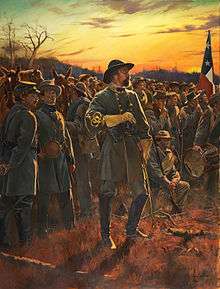John C. Vaughn
| John C. Vaughn | |
|---|---|
 Artist Don Troiani’s 2013 painting of John C. Vaughn titled “General of the Confederacy” | |
| Born |
February 24, 1824 Monroe County, Tennessee, U.S. |
| Died | September 10, 1875 (aged 51) |
| Cause of death | meningitis |
| Resting place | Greenwood, Georgia, U.S. |
| Education | Bolivar Academy |
John C. Vaughn (February 24, 1824 – September 10, 1875) was a Confederate cavalry officer from East Tennessee. He served in the Mexican-American War, prospected in the California Gold Rush, and participated in American Civil War battles including First Manassas, Vicksburg, Piedmont, and Saltville.
Early life and military career
John Crawford Vaughn was born in 1824 on a farm in Monroe County, Tennessee. He probably explored the hills and valleys of East Tennessee on horseback as a youth.[1] From 1830 through 1841 he attended Bolivar Academy in Madisonville, Tennessee.
Career
At 23 in 1847, Vaughn volunteered to fight in the Mexican-American War.[2] He was elected captain and marched to Mexico City, but his regiment saw no military action. He left the military in July, 1848.[3]
In 1850, Vaughn and seventeen other Monroe County men set out for California gold. No fortunes were found, and John was back in Tennessee by 1852. He built a hotel in the new railroad town of Sweetwater. In 1856 he was elected sheriff of Monroe County.[4]
During the American Civil War, Vaughn raised Tennessee's first Confederate regiment and was with Jefferson Davis in the final days of the war.[5] His family was imprisoned by Union forces, and it was several years after the Civil War before he could safely return to Tennessee. Yet, he eventually was elected to the general assembly of his native Tennessee (1871–1873).[6]
Even before Tennessee had seceded, in early 1861 Vaughn recruited two units from Monroe County to support the southern cause. The recruits formed the 3rd Tennessee Infantry Regiment on May 29, and Vaughn was elected colonel.[7] On June 18, Vaughn's men won a skirmish at New Creek near Maryland/West Virginia. On July 21, Vaughn's regiment traveled by train from the Shenandoah Valley to Manassas Junction. The regiment participated in breaking the Union right at the First Battle of Bull Run.[8]
Vaughn's troops moved back to East Tennessee in 1862 and fought against Union factions in Scott County. In May, Vaughn's regiment patrolled the gaps in the northern Cumberland Mountains, winning battles in Tazewell in August and helping to regain control of Cumberland Gap. In September, Vaughn was promoted to brigadier general. In December, General Vaughn's east Tennesseans traveled by train to Jackson, Mississippi.[9]
Vaughn's brigade held heights north of Vicksburg for the first four months of 1863. On May 17, Grant's forces sliced through the Confederate line at the Battle of Big Black River Bridge forcing the surrender of two of Vaughn's regiments. The Confederates retreated into Vicksburg where they eventually surrendered on July 4. Vaughn was paroled and in October began reassembling his troops. He won a skirmish against Union troops in Philadelphia, TN, and also combated marauders in his Monroe County. Working with Longstreet to try and take Knoxville in December, Vaughn was forced to retreat to upper East Tennessee. In late December, Vaughn was authorized to mount his brigade.[10]
In the summer of 1864, Vaughn's cavalry moved to the Shenandoah Valley. On June 5, the Union routed the Confederates at the Battle of Piedmont. The Confederates under Grumble Jones were poorly deployed, and some of Vaughn's cavalry failed to engage. Gordon argues that Vaughn was with his dismounted troops on the Confederate left and not responsible for the inactive units.[11] In September, Vaughn returned to east Tennessee winning an October skirmish near Bull's Gap, but was routed at the Battle of Morristown.[12]
In April 1865, Vaughn and his troops were near Christanburg, Virginia, moving towards North Carolina after news of Lee's surrender. On April 19, Vaughn joined the Jefferson Davis escort in Charlotte. On May 10, Vaughn surrendered.[13]
Indicted for treason in Tennessee, in October, 1865, Vaughn moved his family to Thomas County, Georgia. By 1870, Vaughn had returned to Sweetwater, Tennessee and was elected to the state general assembly (1871–1873). In 1874, he pleaded guilty to using bogus identities to defraud the widow's pension and was fined $1000.[14] In 1874, Vaughn returned to southern Georgia.
Personal life
Vaughn married in the 1840s.
Death and legacy
On September 10, 1875, at the age of 51, he died of meningitis and was buried with military honors at Greenwood, Georgia.[15] His granddaughter, Mary Lua Gibson, married attorney White Burkett Miller.[16]
See also
Notes
- ↑ Gordon, Larry. The Last Confederate General. Minneapolis: Zenith Press, 2009. ISBN 978-0-7603-3517-8. p. 10.
- ↑ Gordon, p. 13
- ↑ Gordon, p. 17
- ↑ Gordon, p. 21
- ↑ Gordon, cover
- ↑ Gordon, p. 176
- ↑ Gordon, p. 24
- ↑ Gordon, pp. 26-36
- ↑ Gordon, pp. 38-49
- ↑ Gordon, pp. 67-82
- ↑ Gordon, p. 99
- ↑ Gordon, pp. 120-136
- ↑ Gordon, p. 156
- ↑ Gordon, pp. 177-180
- ↑ Gordon, p. 181
- ↑ Armstrong, Zeila (1931). The History of Hamilton County and Chattanooga, Tennessee. Chattanooga, Tennessee: Lookout Publishing Company. p. 435. OCLC 1352974.
References
- Eicher, John H., and David J. Eicher, Civil War High Commands. Stanford: Stanford University Press, 2001. ISBN 978-0-8047-3641-1.
- Gordon, Larry. The Last Confederate General. Minneapolis: Zenith Press, 2009. ISBN 978-0-7603-3517-8.
- Sifakis, Stewart. Who Was Who in the Civil War. New York: Facts On File, 1988. ISBN 978-0-8160-1055-4.
- Warner, Ezra J. Generals in Gray: Lives of the Confederate Commanders. Baton Rouge: Louisiana State University Press, 1959. ISBN 978-0-8071-0823-9.
External links
- review of The Last Confederate General
- Vaughn grave